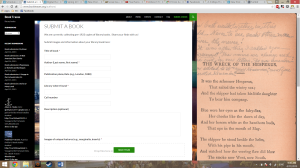Design
Time and time again, clean, organized, aesthetic design and visuals on turn up as key to any Digital Humanities project we have done in class so far. For example, GIS mapping projects should not have all of its data sets appear simultaneously, and should give the viewer the option to toggle on/off individual data sets. In the case of Digital Archives, once again, choice of colors and images used on the home page can have a substantial impact on how the user may come to understand what the theme binds together the information in that particular archive.
Scholarly
This quality is what separates reliable DH projects and questionable ones. All the information used in any particular project should be traceable to their original source, whether it be primary or secondary, especially if the information used did not belong to the makers of the DH Project. On a Digital Archive, this would appear perhaps at the end of each object page or whenever a reference to information that was obtained outside the DH project itself.
User Friendly
Considering that every individual who makes or uses a DH project are not from computer science disciplines themselves, navigating these projects should feel “organic” or fairly easy to learn. Book Traces is one example of such, where the form to fill out the book submission is extremely easy to understand, and even provides an example on the side.
Interactive
On of the advantages of a DH project over physical paper representations of it, is that the user is able to interact with the project by manipulating when certain bits of data or information are shown at a time. The overlay feature of GIS mapping projects is one example of this, or clicking on a pin to reveal more information about that location is another. A not so good example of this would be the maps shown on the “Art in the Blood” fan project.
Collaborative
Last, but not least, DH projects allow for extensive amounts of collaboration with individuals who need not presently be there to do so. So as long as he or she may have access to the tools online needed to make the project, any person can continue on another’s work so as long the project is open to the public. Again, Book Traces is an elegant example of this as contributing to the project’s storehouse of 19th century Marginalia is quick, but thorough.
